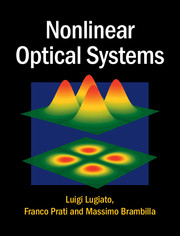Book contents
- Frontmatter
- Dedication
- Contents
- Preface
- Part I Models, propagation, stationary phenomena
- 1 The rate-equation model for the laser
- 2 The interaction of a system of two-level atoms with the electromagnetic field
- 3 The Maxwell–Bloch equations
- 4 Inclusion of the irreversible processes in the atomic equations
- 5 Propagation in irreversible Maxwell–Bloch equations
- 6 Optical nonlinearities. Materials with quadratic nonlinearities
- 7 Optical nonlinearities. Materials with cubic nonlinearities
- 8 Optical resonators. The planar ring cavity. Empty cavity. Linear cavity
- 9 A nonlinear active ring cavity: the ring laser, stationary states
- 10 The adiabatic elimination principle
- 11 A nonlinear passive ring cavity: optical bistability
- 12 Modal equations for the ring cavity. The single-mode model
- 13 Single- and two-mode models
- 14 Nonlinear dynamics in Fabry–Perot cavities
- 15 Inhomogeneous broadening
- 16 The semiconductor laser
- 17 Lasers without inversion and the effects of atomic coherence
- Part II Dynamical Phenomena, Instabilities, Chaos
- Part III Transverse optical patterns
- Appendix A The Routh–Hurwitz stability criterion
- Appendix B Calculation of the oscillatory instability boundary
- Appendix C Coefficients of the characteristic equation (20.20)
- Appendix D Derivation of equations (20.27) and (20.28)
- Appendix E Coefficients of equations (20.60) and (20.61)
- Appendix F The exact boundary of the Risken–Nummedal–Graham–Haken instability
- Appendix G Nonlinear analysis of the roll solution
- References
- Index
11 - A nonlinear passive ring cavity: optical bistability
from Part I - Models, propagation, stationary phenomena
Published online by Cambridge University Press: 05 March 2015
- Frontmatter
- Dedication
- Contents
- Preface
- Part I Models, propagation, stationary phenomena
- 1 The rate-equation model for the laser
- 2 The interaction of a system of two-level atoms with the electromagnetic field
- 3 The Maxwell–Bloch equations
- 4 Inclusion of the irreversible processes in the atomic equations
- 5 Propagation in irreversible Maxwell–Bloch equations
- 6 Optical nonlinearities. Materials with quadratic nonlinearities
- 7 Optical nonlinearities. Materials with cubic nonlinearities
- 8 Optical resonators. The planar ring cavity. Empty cavity. Linear cavity
- 9 A nonlinear active ring cavity: the ring laser, stationary states
- 10 The adiabatic elimination principle
- 11 A nonlinear passive ring cavity: optical bistability
- 12 Modal equations for the ring cavity. The single-mode model
- 13 Single- and two-mode models
- 14 Nonlinear dynamics in Fabry–Perot cavities
- 15 Inhomogeneous broadening
- 16 The semiconductor laser
- 17 Lasers without inversion and the effects of atomic coherence
- Part II Dynamical Phenomena, Instabilities, Chaos
- Part III Transverse optical patterns
- Appendix A The Routh–Hurwitz stability criterion
- Appendix B Calculation of the oscillatory instability boundary
- Appendix C Coefficients of the characteristic equation (20.20)
- Appendix D Derivation of equations (20.27) and (20.28)
- Appendix E Coefficients of equations (20.60) and (20.61)
- Appendix F The exact boundary of the Risken–Nummedal–Graham–Haken instability
- Appendix G Nonlinear analysis of the roll solution
- References
- Index
Summary
In Chapter 9 we discussed the case of a nonlinear cavity containing an active medium. In this framework, the outstanding phenomenon which arises is laser emission, and we calculated the stationary solutions for the ring laser. In this chapter, instead, we turn our attention to the passive nonlinear cavity and in this framework the outstanding phenomenon is optical bistability, i.e. the existence of two distinct stable stationary states that coexist for the same fixed values of the parameters in play. This phenomenon can arise also in the case of an active system contained in a cavity, as we have already noted in Section 9.1 and as we will discuss further in connection with the laser with injected signal, but it became popular from the studies of nonlinear passive optical cavities in the 1970s and 1980s.
In contrast to the laser case, in the passive configuration we use an input coherent field, which is injected into the cavity. We discussed this case in Chapter 8 and derived a general equation for the transmission of the cavity (Eq. (8.23)), which we used for an empty cavity and for a linear cavity in Sections 8.4 and 8.5, respectively. In this chapter we will discuss the full nonlinear configuration.
It is customary to identify two extreme cases of optical bistability called absorptive optical bistability and dispersive or refractive optical bistability. In both cases an essential ingredient to obtain the bistable behavior is the feedback action exerted by the mirrors of the cavity. In the purely absorptive configuration, in which there is exact resonance among the frequencies of the input field, of the atoms and of the cavity, the other essential ingredient is the saturable nonlinearity of the absorption. In the dispersive case, instead, the main feature is the nonlinearity of the refractive index.
These two cases will be illustrated in Sections 11.1 and 11.2, respectively, both “exactly” and in the low-transmission limit.
- Type
- Chapter
- Information
- Nonlinear Optical Systems , pp. 112 - 125Publisher: Cambridge University PressPrint publication year: 2015

